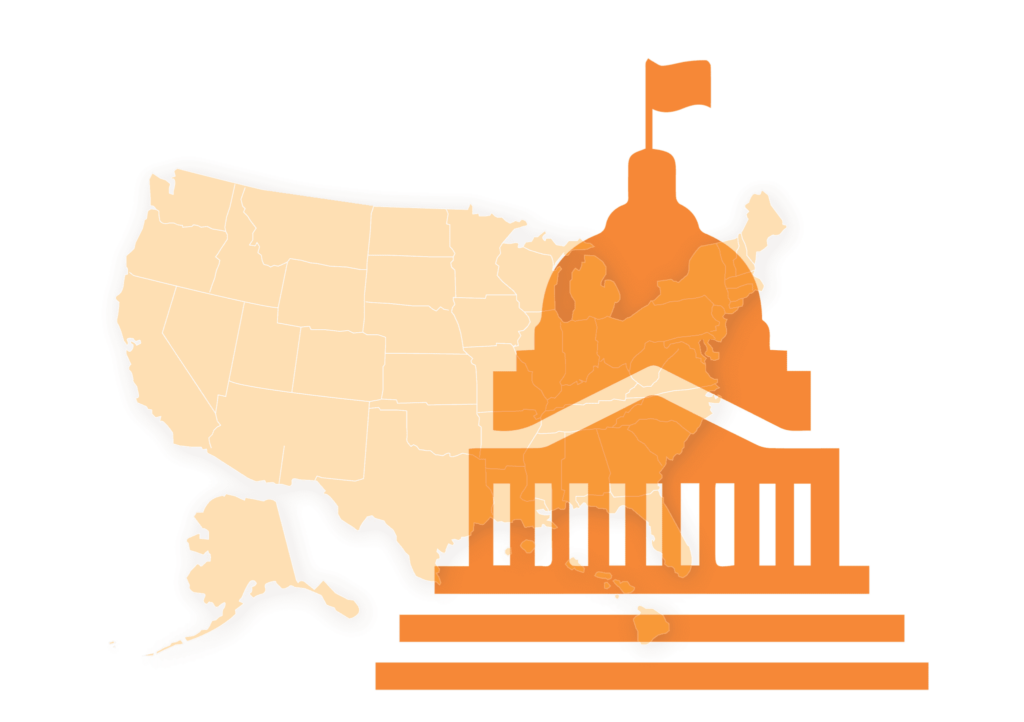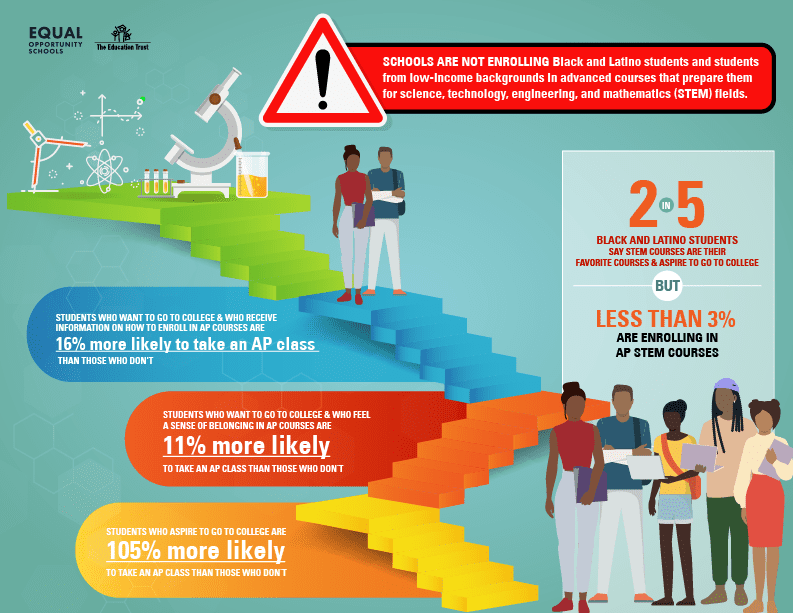Ed Trust Identifies the Barriers That Keep Black and Latino Students Unequally Represented in Advanced Coursework
WASHINGTON – Black and Latino students across the country have unequal access to advanced coursework, which means they often miss out on vital learning opportunities that can set them up for success in college and careers. A new report and state-by-state data tool from The Education Trust examine why these students are shut out, how widespread these practices are, and what policymakers at the state, district, and school level can do to increase students’ access to advanced learning.
These missed opportunities happen along the educational spectrum:
- Elementary school: Black students represent 16% of overall enrollment in elementary schools, but only 9% of enrollment in gifted and talented programs; Latino students are 28% of students enrolled in elementary schools, but only 18% of those in gifted and talented programs.
- Middle school: Black and Latino students are not adequately enrolled in eighth grade algebra. Black students make up 15% of eighth graders, but only 10% of students enrolled in eighth grade Algebra I. Similarly, Latino students make up 25% of eighth graders and just 18% of eighth graders in the course.
- High school: Black and Latino students are locked out of Advanced Placement (AP). Black students make up 15% of high schoolers nationwide, but only 9% of students enrolled in at least one AP course. Nearly a quarter of students are Latino, but only 21% of students enrolled in AP courses are Latino.*

Using data from the U.S. Department of Education’s 2015-16 Civil Rights Data Collection (CRDC) and Common Core of Data (CCD), Inequities in Advanced Coursework: What’s Driving Them and What Leaders Can Do shows that nationally, there are two drivers of these inequities: (1) schools that serve mostly Black and Latino students do not have as many seats in advanced classes as schools that serve fewer Black and Latino students; and (2) schools — especially racially diverse schools — deny Black and Latino students access to those seats that they do have. Additionally, fair access doesn’t mean sufficient access: Too many students attend schools that do not offer these opportunities at all.
“Advanced coursework opportunities can place students on the path toward college and career success. Yet, too many Black and Latino students never receive the opportunity to enroll through no fault of their own. No student should forfeit future success because there were not enough seats in the class or because the seats were not available,” said Kayla Patrick, Ed Trust’s P-12 data and policy analyst and lead author of the report.
The report points to systemic obstacles that block Black and Latino students from entering advanced courses, including:
- Resource inequities caused by funding gaps in school districts that serve large populations of students of color have a profound effect on the educational opportunities districts and schools are able to provide.
- Educator bias is one of the biggest barriers for Black and Latino students, when school leadership overly rely on the recommendations of teachers and counselors whose judgments may be shaped by implicit or explicit racial bias.
- Assessment and grading biases are prevalent in testing and grading practices.
- Lack of access to diverse educators is consequential for all students but particularly for Black students whom Black teachers play a large role in identifying as gifted or not.
- Inequitable access to quality early childhood opportunities contributes to differences in the quality of children’s early childhood experiences and can affect the way educators identify giftedness in young children.
- Lack of communication with families — including lack of communication in families’ home languages — about advanced opportunities makes it unnecessarily difficult for families to find information on the enrollment process.
Key findings show:
- Black and Latino students are successful in advanced courses when given the opportunity.
- Black and Latino students are not fairly represented in advanced courses.
- There are too few course offerings and limited availability.
- Not enough courses are offered in schools across the country.
- Not enough total seats are available in the schools serving the most Black and Latino students.
- Among schools that offer advanced courses, Black and Latino students are often denied access to those courses. This is especially true in racially diverse schools.
Access to advanced coursework opens up new worlds for students. Bianka Aguirre, a recent Mexican American graduate of Artesia High School in California, and first-year, pre-medical student at UCLA, credits enrollment in AP classes for her decision to pursue a career in medicine. “If I had taken a regular biology course, it wouldn’t have been as engaging, because we wouldn’t have done as many labs and I wouldn’t have known that I’m really passionate about science.”
State advocates have pushed for several polices designed to address inequities in advanced coursework:
- Illinois — competitive grants to low-income districts to increase AP capacity
- Colorado — funding for universal screening for gifted and talented programs
- Washington — automatic enrollment for students who meet or exceed standards on the state test in the next most rigorous level of the course
- Florida — policies that are intentional around expanding access for underserved students, including providing free PSAT tests and better professional development for teachers
“Black and Latino students can succeed in advanced coursework when given the opportunity,” said Heather Rieman, director of P-12 policy. “Policymakers can improve the lives of Black and Latino students by implementing meaningful policy changes. Students in advanced courses have proven to work harder and engage more in school, leading to fewer absences and suspensions, as well as higher graduation rates.”
Ed Trust recommends five ways district and state policymakers can advance equity in access to and success in advanced coursework:
- Set clear, measurable goals for advancing access to and success in advanced coursework and commit to publicly measuring state and district progress (disaggregated by race and income) toward those goals.
- Use data to identify the barriers that prevent students of color and students from low-income backgrounds from enrolling in advanced courses.
- Where schools serving the most Black and Latino students lack any or enough advanced courses, states should invest to expand advanced coursework opportunities in those schools — either through more courses or seats or both.
- Where Black and Latino students do not have a fair chance to take advantage of advanced coursework opportunities already offered within their schools, states should require and support districts to expand eligibility and increase access to advanced courses.
- Finally, states should provide sufficient support for students to prepare for advanced coursework and for their success once enrolled. States should also support districts by providing the resources necessary to prepare students for advanced coursework opportunities.
###
* The Civil Rights Data Collection no longer reports the number of students taking world languages. However, data from College Board suggest that the overall representation of Latino students in AP is slightly inflated by participation in AP Spanish. In 2018, Latino students took 23% of all advanced placement exams and 71% of the AP Spanish and Culture exams.
 Advanced Coursework Data Tool
Advanced Coursework Data Tool
The tool is designed to help advocates better understand state-level inequities so that they can advocate for state-level solutions. The data in this tool examines whether Black and Latino students are fairly represented in advanced courses, in each state, at three key points in their schooling — gifted and talented in elementary school, algebra in eighth grade, and Advanced Placement in high school.
Users can:
- Select an advanced coursework opportunity and student group to see state-by-state data that will identify whether there are inequities in access, help diagnose what’s happening in their state, and identify appropriate policy solutions.
- Click on a state’s bar in any chart or select it from the drop-down menu to highlight how that state is doing on each measure of access to advanced coursework.
- Hover over a state’s bar in any chart to learn more about how that state is doing on that measure of access and participation, and what state leaders can do to address inequities.






 Advanced Coursework Data Tool
Advanced Coursework Data Tool

